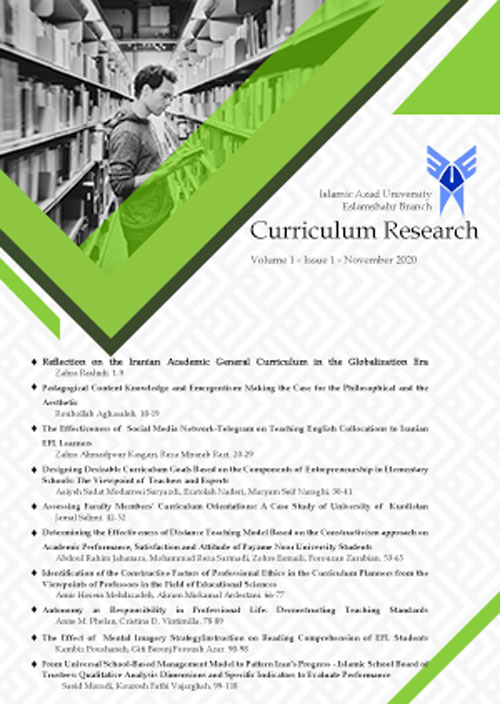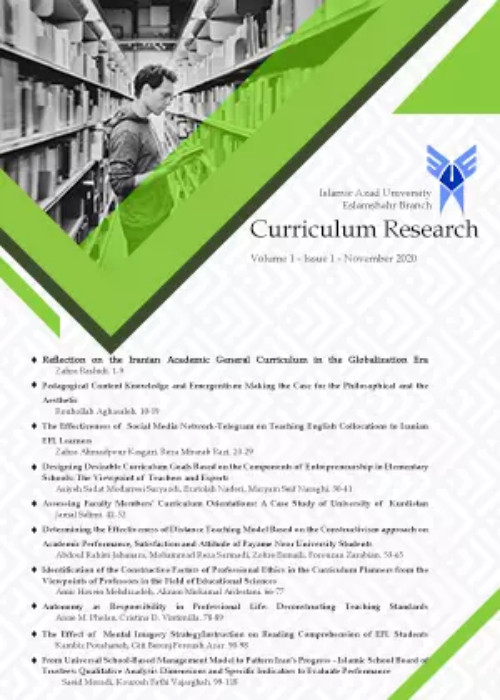فهرست مطالب

Curriculum Research
Volume:2 Issue: 2, Apr 2021
- تاریخ انتشار: 1400/11/20
- تعداد عناوین: 6
-
Pages 1-10Purpose
The aim of this study was to determine the contribution of each of the environmental and organizational components in students' professional ethics.
MethodologyThis study was conducted with a mixed approach of exploratory design of categorization type. The present study is an applied research in terms of purpose, and research strategy in the qualitative part, content analysis and in the quantitative part of the survey. The statistical population in the quantitative part of the research included the faculty members of the Islamic Azad University of Tehran, whose number was 5921 in 1397. To calculate the qualitative part, according to Morgan table, 360 samples are enough for a community of 5921 people, and a total of 400 questionnaires were distributed to increase the size accuracy. In order to collect the required data in the qualitative phase, the judgmental sampling method up to the theoretical saturation stage was used. The method of data collection in the qualitative phase of the research, in addition to reviewing the literature, was a semi-structured interview. Then all research data were analyzed in two parts using SPSS24 statistical software. Data were analyzed using exploratory and confirmatory factor analysis.
FindingsThe results of factor analysis showed that all indicators related to organizational and environmental factors have acceptable t values (more than 1.96) and factor load (more than 0.4) and indicators for organizational and environmental factors. Are considered suitable.
ConclusionAlso, considering that the t-statistic of both variables is more than 2.57, at the level of 99% confidence.
Keywords: professional, organizational, student, Environmental ethics -
Pages 11-19Purpose
The present research was conducted with the aim of comparison of psychomotor skills and social adjustment in elementary students with and without preschool history.
MethodsThis research in terms of time was cross-sectional, in terms of purpose was applied and in terms of implementation method was causal-comparative. The study population was the first to third grade students of Shiraz KodakAfarin Educational Complex in the academic years of 2019-2020, which according to the Krejcie and Morgan table number of 144 people (90 people with preschool history and 54 people without preschool history) were selected as a sample by simple random sampling method. Data were collected by psychomotor skills test (Lincoln Oseretsky, 1950) and adaptive behaviors inventory (Lambert et al, 1974) and analyzed by independent t-test in the SPSS software.
FindingThe results showed that elementary students with preschool history in compared to elementary students without preschool history significantly had a more favorable situation in terms of psychomotor skills (and all its components including touching, bending on the toe, harmonious tapping of the foots, standing on one foot, walk backwards and finger skills) and social adjustment (and all its components including violent behavior, antisocial behavior, rebellious behavior, unreliable behavior, avoidance, stereotyped behavior, inappropriate social behaviors, bad voice habits, bad or strange habits, hyperactivity tendency and psychological distress) (P<0.01).
ConclusionThe results indicated the effect of preschool on psychomotor skills and social adjustment in elementary students. Therefore, to improve the characteristics of students is necessary to use a preschool education course.
Keywords: Psychomotor Skills, social adjustment, Elementary Students, preschool -
Pages 20-31Purpose
The aim of this study was to evaluate the nature of multicultural teaching from the perspective of professors of Islamic Azad University of Kermanshah.
MethodologyThe approach of the present study is qualitative and applied in terms of purpose. The statistical population includes a range of types of professors in the three fields of humanities, basic sciences and engineering of the Islamic Azad University of Kermanshah province. Snowball sampling is a non-random method. In this method, future members of the group are selected and introduced through former members of the group. The number of samples in this study is 27 after reaching the theoretical saturation. Semi-structured interviews were used to collect data. The findings were analyzed by content analysis method by MaxQDA software.
FindingsThe findings indicated that the nature of multicultural teaching includes the scope of teacher education, macro policies of the educational system, manpower, barriers and problems of multicultural teaching and teaching outcomes.
ConclusionProfessors with a greater understanding of the multiplicity of students' culture, welcome multicultural teaching to improve the quality of teaching for all students and be able to overcome the challenges in this field with more reflection.
Keywords: : Essay Essay Essay, Multicultural Teaching, Teachers' Perception, Islamic Azad University -
Pages 32-43Purpose
The aim of present research was identifying the effective components on managing the challenges of thesis writing based on the lived experiences of PhD students in Islamic Azad University.
MethodologyThis study in terms of purpose was applied and in terms of implementation method was phenomenological from type of qualitative. The research population was students and graduates of the PhD period of humanities fields at the Islamic Azad University in 2020-21 academic years. The research sample according to the principle of theoretical saturation was determined 12 people which were selected by purposive sampling method. Data were collected by semi-structured interviews whose validity by 15 professors was obtained by the relative content validity coefficient method 0.866 and its reliability by the Holsti coefficient method was obtained 0.865. Finally, the data were analyzed by open, axial and selective coding method in MAXQDA-18 software.
FindingsThe results showed that for managing the challenges of thesis writing based on the lived experiences of PhD students were identified 67 indicators in 13 sub-components and 3 main components. The main components were included administrative-organizational solutions (with three sub-components of maximum use of virtual systems, modification of the thesis doing process and financial assistance), solutions (with three sub-components of increase study, proper planning and strengthening skills) and educational strategies
ConclusionThe results of this study have practical implications for graduate officials and planners, and they can use the identified components to properly manage the challenges of thesis writing and improve them in the higher education system.
Keywords: Challenges of thesis writing, lived experiences, PhD students -
Pages 44-54Purpose
The purpose of this study was to investigate the effect of self-esteem on jealousy and organizational citizenship behaviors of the staffs of general sport and youth departments of western provinces of Iran.
MethodologyThe research method is descriptive-correlational. The statistical population of this study includes all managers, presidents and staffs of sport and youth departments in west of Iran with 300 persons (Kermanshah 72 people, Ilam 68 people, Hamedan 57 people, Lorsan 53 people and Kordestan 50 people) and the sample was considered as the whole population. The instruments used in this study were standard questionnaires of Rahmani et al. (2010) anti-citizenship behavior questionnaire, Vecchio organizational jealousy questionnaire (2000) and Gardner self-esteem questionnaire (2000) that their reliability was 0.962, 0.849 and 0.921, respectively. The questionnaires were reviewed by eight experts in management and their ambiguities were somewhat resolved. This demonstrates the acceptable appearance and content validity of the compilation tool. Descriptive and inferential statistics (variance-based structural equation modeling) were used to analyze the data. In addition, the research hypotheses were analyzed at the 0.05 level of error using Smart PLS3 software.
FindingsThe findings showed that organizational self-esteem had a significant and negative effect on organizational citizenship behavior and organizational jealousy, meaning that with increasing self-esteem, organizational citizenship and organizational jealousy would decrease.
ConclusionOrganizations today are looking for new approaches in management, so that they can make the best use of their human and physical resources and increase their work efficiency. The main purpose of this study is to identify the effect of organizational self-esteem on organizational jealousy and anti-organizational citizen behavior.
Keywords: Self-Esteem, Organizational Jealousy, Organizational Anti-Citizenship Behavior, Sports, Youth Offices -
Pages 55-63Purpose
The aim of this study was to investigate the role of problem solving skills in self-efficacy and social adjustment of female high school students.
MethodologyThe present study was applied research in terms of purpose, quantitative in terms of data type, and descriptive-correlational in terms of survey method. The statistical population of the present study included all female high school students in Kermanshah in the academic year 1401-1400 in the number of 4100 people. Based on Krejcie and Morgan table, a sample of 350 people was selected by one-stage cluster sampling method. Data were collected using three problem-solving skills questionnaires by Hepner and Peterson (1982) 35 items, Scherer self-efficacy questionnaire (1982) 17 items, and Sinha and Singh (1993) 20-item social adjustment questionnaire. The face validity of the questionnaires was verified by experimental implementation among 30 students and the content validity of the questionnaires was evaluated and confirmed by expert judgment and comprehensive literature review. Self-efficacy was 0.82 and social adjustment was 0.87. Kolmogorov-Smirnov test (K_S) was used to analyze the data to determine the normality of data distribution, Pearson correlation coefficient to determine the correlation coefficient, and regression analysis to determine the coefficient of explanation using SPSS statistical software.
FindingsThe results showed that there is a positive and significant relationship between problem solving skills with self-efficacy and social adjustment at the alpha level of 0.01 (p <0.01).
ConclusionBased on this, it is concluded that students who have higher problem solving skills have more self-efficacy and social adjustment.
Keywords: problem solving skills, self-efficacy, social adjustment, students


